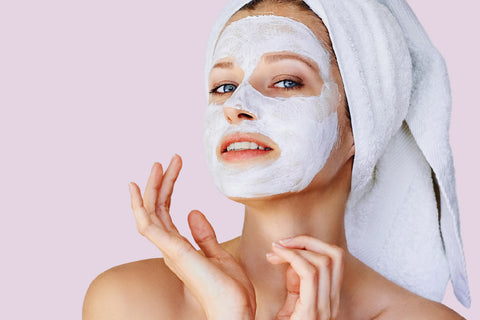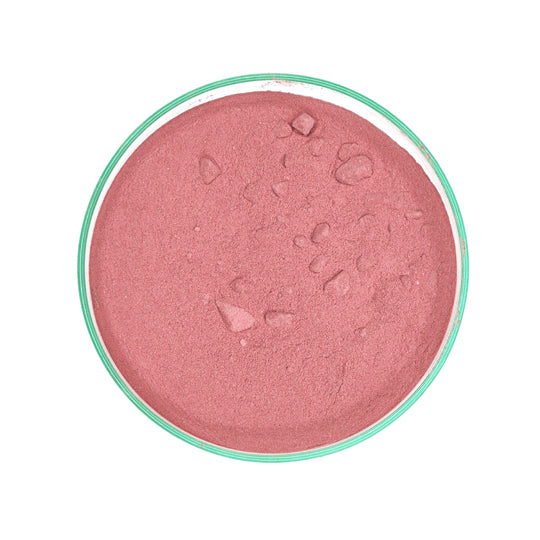For centuries, Hibiscus power has been used in Ayurvedic medicine and skincare routine for its numerous skin benefits. It is loaded with vitamins, antioxidants, and AHAs that do wonders for the skin to keep it healthy.

It is not used for skin whitening but for anti-ageing, hydration, exfoliation, and soothing inflammation. It is the perfect ingredient for all skin types whether it be dry, oily, combination, acne-prone, or sensitive skin.
What is Hibiscus Powder?
The dried, crushed sepals of the hibiscus plant are used to make hibiscus powder. They are thick, trumpet-shaped, deep maroon fruits that develop after hibiscus flowers bloom yet are sometimes mistaken for blooms.
This acidic, finely crushed powder has a rich maroon hue. The hibiscus plant is more than simply a decorative thing. Hibiscus may be used to care for your skin and cure a number of skin conditions. In addition, it has been frequently employed in traditional Indian medicine to treat various illnesses.
Is Hibiscus Powder Good For Skin?
The hibiscus powder has antigenotoxic qualities, antiulcer, antifertility, antibacterial, antioxidant, and antidiabetic, and may prevent liver damage.

The hibiscus is significant in skin care since it contains necessary minerals, proteins, vitamins, acids, lipids, and flavonoids. Hibiscus powder for skin is super hydrating and nourishing.
Benefits of Hibiscus Powder For Skin Whitening
Hibiscus powder for the skin is a fantastic product to incorporate into our summer skincare routine because it has many beneficial qualities. The following section discusses the advantages of hibiscus powder for the skin and explains how to utilize it to maintain healthy, young skin.
- Fights Aging Signs: Hibiscus has a legendary reputation for boosting skin elasticity to deliver a spectacular natural youth boost and is one of the most potent anti-aging plant actives.
- Evens Skin Tone: Age spots or hyperpigmentation are one of the outward indications of skin aging. Age spots can develop due to various factors, including exposure to UV light, excessive melanin synthesis, and heredity.

- Antioxidant: Antioxidants, or anthocyanocides, are abundant in hibiscus. Anthocyanocides contain qualities that aid to minimise the appearance of big pores for a smoother complexion and protect against free radical damage.
- Purifies Skin: By dissolving dead skin cells and accelerating cell turnover, the natural acids found in hibiscus aid skin purification and can even help manage acne outbreaks. The organic acids from hibiscus restore your skin's equilibrium for a naturally attractive, glowing complexion, unlike harsh synthetic versions of these acids that can strip your skin of its natural oils.
- Moisturizes Skin: Hibiscus has a naturally high mucilage content, a gooey material made by plants that aid in storing food and water. So a terrific natural skin moisturizer kind to delicate skin is mucilage.
- Prevents Acne: Acids in the hibiscus function as chemical exfoliators and aid in unclogging congested skin pores. Additionally, it possesses antimicrobial qualities that serve to combat skin-damaging germs. Thus, it stops pimples from forming. In addition, hibiscus-containing anti-acne formulations are very effective in reducing bacterial activity on the skin and curing acne.

- Speeds Up Wound Healing.: Hibiscus helps wounds heal more quickly by boosting the skin's fibronectin protein synthesis. Additionally, it promotes skin hydration and cell regeneration, both of which are crucial for the healing of wounds. Hibiscus powder increases the skin's capacity for healing by quickening the healing of wounds and promoting the expression of biomarkers related to hydration and skin regeneration.
How To Use Hibiscus Powder For Skin Care?
These are a few of the most significant hibiscus powders for skin care advantages. So, how can hibiscus powder be used to promote improved skin health? Below are a few significant DIY recipes that may be of use.
Recipe 1. Hibiscus Cleansing Mask
Hibiscus powder has been described as having natural exfoliating properties. Try this moisturizing and softening scrub to eliminate dead skin cells and stop acne outbreaks.

Ingredients:
- Honey - 1 Tablespoon
- Sugar Granules - 1 Tablespoon
- Hibiscus powder - 1 Tablespoon
Directions:
Step 1:First, combine the honey, granulated sugar, and hibiscus powder thoroughly.
Step 2: While in the shower, gently scrub this mask on your moist facial skin
Step 3: After about five minutes of circular movements, rinse with cold water.
Recipe 2. Hibiscus As Body Scrub
Due to the exotic perfume of ylang-ylang essential oil, this homemade sugar scrub has a beautiful tropical scent. Additionally, this organic skin-nourishing scrub has pulverized hibiscus powder, which has antioxidant properties, helps with gentle exfoliating, and provides a beautiful color.

Ingredients:
- Coconut Oil - 1 Tablespoons
- granulated organic sugar- 1 Cup
- Ylang-Ylang Essential Oil - 10 Drops
- Hibiscus Powder - 1 Tablespoons
Directions:
Step 1: Mix the granulated sugar and fractionated coconut oil in a large glass dish. And Mix well before adding the ylang-ylang essential oil.
Step 2: Next, add your hibiscus powder and keep mixing till everything is blended. And Place the scrub in a glass or mason jar with a tight-fitting cover.
Step 3: Apply your scrub in a circular motion to clean the skin, then thoroughly rinse with water.
Step 4: The coconut oil should be left on your skin since it moisturizes. So make sure to shower before using your scrub, and don't use any soap afterward.
Recipe 3. Treat Dry & Flaky Skin Conditions
This hibiscus powder face mask tones your skin while intensely hydrating it. It could also aid in skin cleansing and exfoliation. However, if you have delicate skin, omit the lemon juice.

Ingredients:
- Aloe Vera Gel or yogurt - 1 Tablespoons
- Hibiscus powder - 1 Teaspoons
Directions:
Step 1:Combine the hibiscus powder with the aloe vera gel or yogurt. Add a few drops of lemon juice next (if you do not have sensitive skin).
Step 2: Combine the ingredients thoroughly to create a thick paste. And Apply it to your face and neck and let it sit for around 30 minutes.
Step 3: This face mask may be used daily for a month to treat dry skin and internally renew your skin.
Recipe 4. Hibiscus Powder For Skin Whitening
This hibiscus powder face mask has several skin-whitening benefits. It will enhance your facial skin's glow and unclog your pores, improving blood circulation for a brighter complexion.

Ingredients:
- Honey - 1 Teaspoons
- Apple Cider Vinegar - 5 Drops
- Bentonite Clay - 1 Teaspoons
- Hibiscus Powder - 4 Tablespoons
Directions:
Step 1: Hibiscus powder should be combined with apple cider vinegar and honey in a blender until thick paste forms.
Step 2: Apply this face mask to a clean, dry face, and then rinse it off with warm water.
Conclusion
Numerous skin issues can be treated using hibiscus powder as a natural remedy. It can benefit your skin in a variety of ways like preventing acne and restoring your face's glow.
Hibiscus skin care also reduces the appearance of age, offers natural exfoliation, calms your skin, and enhances skin radiance. If you are wondering where you can get your hands on some 100% organic hibiscus powder, then look no further than Veda oils! Check us out now.
Frequently Asked Questions
Let’s try to answer some of the questions that you might be having about using hibiscus powder for skin.

Q. How Do I Use Hibiscus Powder On My Face?
Ans. Combine rose water and hibiscus flower powder to make a paste. Apply to the entire face, avoiding the delicate area around the eyes, to gently yet effectively exfoliate the skin. When the mask is removed, the skin will appear radiant and healthy and pores are cleaned.
Q. Does Hibiscus Powder Lighten Skin?
Ans. Yes. Hibiscus contains AHAs that aid to improve the texture and tone of the skin.
Q. Can We Use Hibiscus Powder Daily?
Ans. Yes. Hibiscus powder can significantly enhance your health when taken everyday over a period of 1-2 months.













 Sign in
Sign in Register now
Register now My Reward Points
My Reward Points









